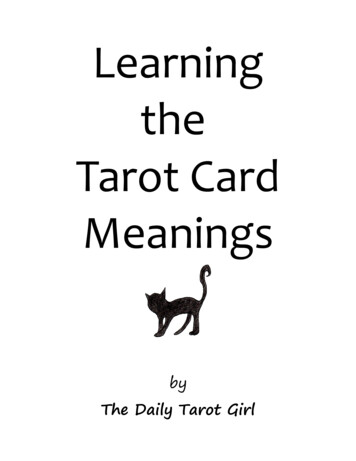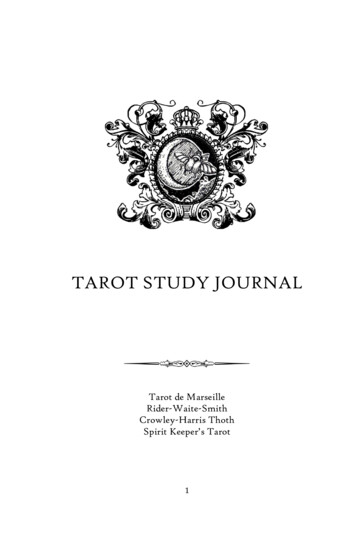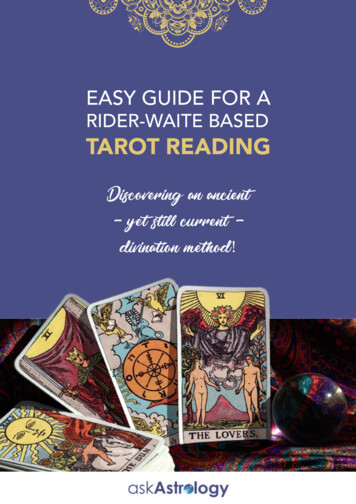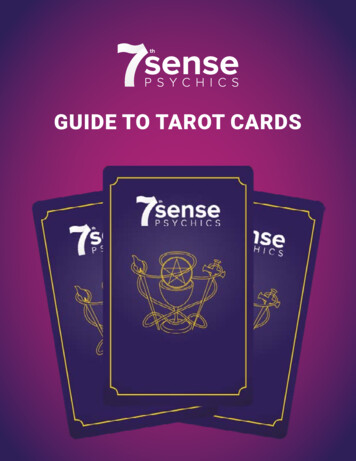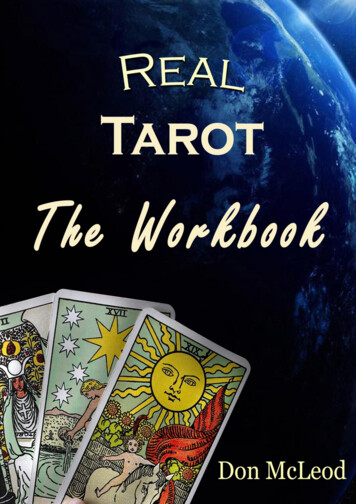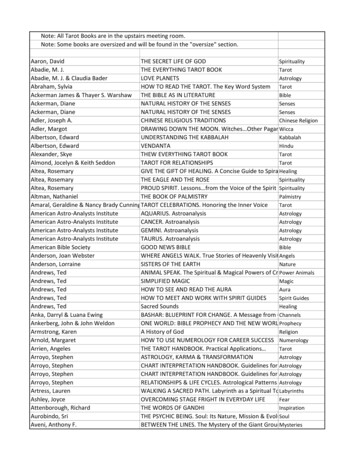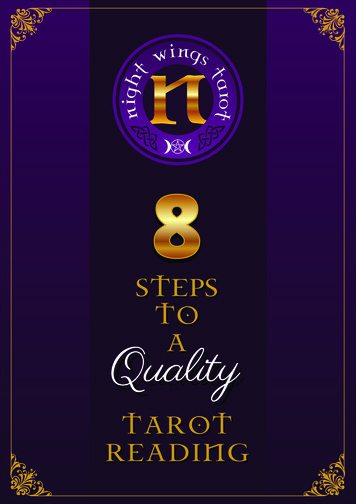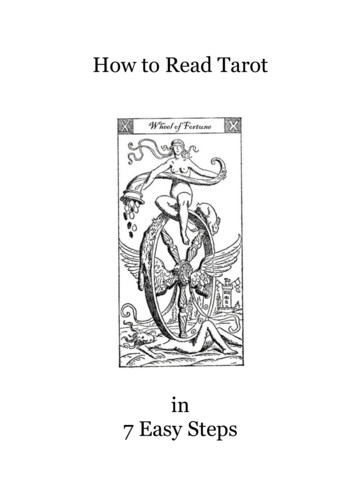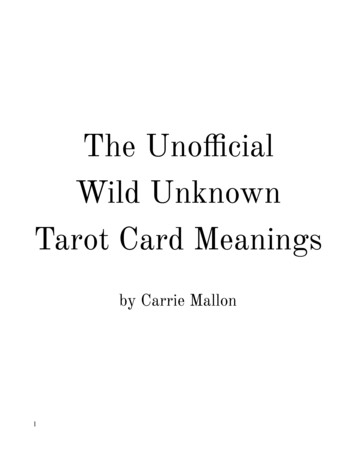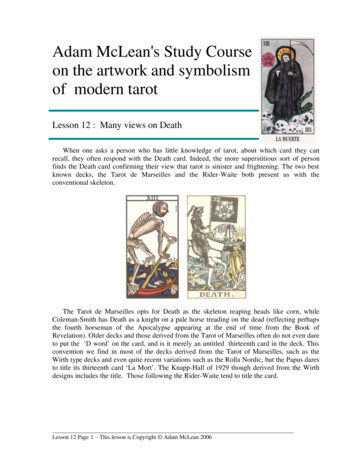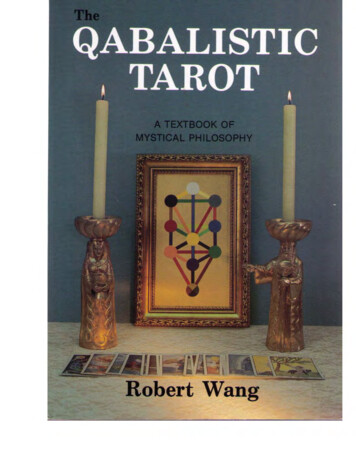
Transcription
TheQABALISTICTAROTA TEXTBOOK OF MYSTICAL PHILOSOPHYRobert WangSAMUEL WEISER, INC.York Beach, Maine
The Tarot Symbols on the Tree of Life.
CONTENTSPREFACE, xvINTRODUCTION,Modem Tarot Studies: A Nineteenth Century Legacy1The Search For "Truth" . . . . . . . . . . . . . . . . . . . . . . . . . . . . . . . . . . . . . . . . . . 5The Golden Dawn10The Golden Dawn Tarot12The Rider- Waite Deck1314Aleister Crowley's Thoth TarotBook "T" . . . . . . . . . . . . . . . . . . . . . . . . . . . . . . . . . . . . . . . . . . . . . . . . . . . . 15THE QABALAHOrigins of the QabalahThe Sepher Yetzirah (Book of Formation)Medieval QabalismThe Renaissance: Hermeticism and Christian QabalahMagus to the QueenRosicrucianism . . . . . . . . . . . . . . . . . . . . . . . . . . . . . . . . . . . . . . . . . . . . . . . . .Later "Rosicrucians"Hermetic-Qabalistic DeceptionsHermetic-Qabalah and The Golden DawnThe Tree of LifeConcepts"Secret" PathsNegative Limitless LightThe Four WorldsQabalistic SymbolismThe Sephiroth and Their SymbolsThe Minor CardsThe Court Cards202121232525262728293237393943444750
PATTERNS OF THE SEPHIROTHKether, The CrownThe AcesChokmah, WisdomThe TwosThe KingsBinah, UnderstandingThe ThreesThe QueensDaath, KnowledgeChesed, MercyThe FoursGeburah, StrengthThe FivesTiphareth, BeautyThe SixesThe PrincesNetzach, VictoryThe SevensHod, SplendorThe EightsYesod, FoundationThe NinesMalkuth, KingdomThe TensThe PrincessesTHE MAJOR ARCANA ON THE TREE OF LIFEApplications of the Sepher YetzirahThe Matemals: Air, Water, FireThe Double Letters: Planets, Localities, Days, Gateways,ContrastsThe Simple Letters: Signs of the ZodiacThe Cube of SpaceNumerologySets of Paths . . . . . . . . . . . . . . . . . . . . . . . . . . . . . . . . . . . . . . . . . . . . . . . . . . .The Initiatory Scheme of the TarotTHE UNIVERSE, TauJUDGMENT, ShinTHE SUN, ReshTHE MOON, QophTHE STAR, TzaddiTHE TOWER, PehTHE DEVIL, AyinTEMPERANCE, 162166172176
DEATH, NunTHE HANGED MAN, MemJUSTICE, LamedWHEEL OF FORTUNE, CaphTHE HERMIT, YodSTRENGTH, TethTHE CHARIOT, ChethTHE LOVERS, ZainTHE HIEROPHANT, VauTHE EMPEROR, HehTHE EMPRESS, DalethTHE HIGH PRIESTESS, GimelTHE MAGICIAN, BethTHE FOOL, CTICAL WORKSkryingDivination251252REFERENCEColors on the Tree of LifeColors and Sounds on the Tree of LifeAngels of the DecansDivine Names of the SephirothThirty-Two Paths of Wisdom263264265265266NOTES, 267INDEX, 279
ILLUSTRATIONSColor. Plate I, The Tarot Symbols on the Tree of LifeColor Plate II, The Tree of Life in a "Solid Sphere"Fig. 1 The Ten Holy Sephiroth on the Tree of LifeFig. 2 Development of the Tree of Life diagramFig. 3 The Path of the Flaming SwordFig. 4 The Triangles of the Tree of LifeFig. 5 The Pillars on the Tree of LifeFig. 6 The Divisions of the SoulFig. 7 Attribution of Elements to the PentagramFig. 8 The "Secret Paths" on the Tree of LifeFig. 9 The Four WorldsFig. 10 The Four ElementsFig. 11 Attribution of the Minor Arcana to the Tree of LifeFig. 12 The Court Cards on the Tree of LifeFig. 13 The Signs of the Zodiac in the Twelve HousesFig. 14 The DecansFig. 15 Attribution of the Minor Cards and the CourtCards to the ZodiacFig. 16 Attribution of Planets to the HexagramFig. 17 The Symbol of Venus on the Tree of LifeFig. 18 Attribution of the Major Arcana to the Tree of LifeFig. 19 Attribution of MaternalFig. 20 The Cards on the "Path of the Flaming Sword"Fig. 21 Planetary attributions to the Tree of LifeFig. 22 Signs of the Zodiac on the Tree of LifeFig. 23 The Signs of the Zodiac on the Tree of Life asCardinal, Fixed, and Mutable ElementsFig. 24 The Cube of SpaceFig. 25 Cards considered as OppositesFig. 26 The Cards on the Middle 130132133134137138
Fig.Fig.Fig.Fig.Fig.Fig.272829303132The Paths from the Thirty- Two Paths of WisdomPatterns of Form and Force on the Tree of LifeParts of the SoulThe Tree of Knowledge of Good and EvilLevi's Interpretation of the Wheel of EzekielTwo Ways of Representing that which is encompassedby Mercury139140142165196242
PREFACEThe purpose of this book is to demonstrate the relationship between theQabalah, a time-honored mystical system, and the Tarot. To do so is topointedly disagree with some very great Jewish scholars, who state that no suchrelationship exists.What I have attempted to do in this work is to integrate some of the verycomplex threads of Qabalistic symbolism and interpretation, emphasizing therelationship of the Tree of Life (primary symbol of the Qabalah) and the Tarotas taught in the tradition of the Hermetic Qabalah. I must emphasize that I amnot writing on the Hebrew Qabalah, but on a separate and distinct system alsobased on Hebrew texts. In my opinion, the Hebrew scholars have been mistakenin their perception of late nineteenth century occult developments as merely aromantic and misunderstood pastiche of mystical Hebrew lore.Moreover, I have attempted to demonstrate that the principles of theQabalah are appropriately applied to any ordinary Tarot deck. To that end thiswork reproduces four entire decks, including the Marseilles Tarot. Very littlediscussion is accorded that work, chosen as a comparison with the moresymbolically concise modem decks because it is the most common and popularof the decks crystallizing the cards' early imagery. The Marseilles Tarot is a"standard" deck, the other three decks used here are those related to thenineteenth century occult fraternity, The Hermetic Order of the Golden Dawn.Those decks are The Golden Dawn Tarot, The Thoth Tarot and The Rider- Waitedeck. One other deck, not shown, but which I recommend very strongly, is thatof the late Paul Case and his organization, The Builders of the Adytum. This isa deck to be hand colored by each student.Besides this deck, Case produced some exceptionally good Tarotliterature, to which I have devoted considerable attention. His correspondencecourses on Tarot, written more than forty years ago, are still being distributed.And, since distribution is restricted, I must quickly note that I am in no way
xviThe Qabalistic Tarotassociated with that organization, having been provided a complete set of hiscourses by sympathetic friends.Case was a brilliant teacher who must be credited as the first to applythe terms of modem psychology to the cards, an approach very much like that ofCarl Jung. I consider Case to be the first great modem scholar on the Tarot,unrecognized as such generally because his major works have been availableonly to corresponding students of the Builders of the Adytum, who are askedthat they be kept confidential.I have found his ideas, which have influenced my approach, veryprofound, but with reservations. I question his dogmatic reliance on Gematria(Qabalistic numerology), as well as some of his interpretations of Waite'ssymbolism. Moreover, at the time Case was writing, our psychological languagewas in a state of development, and his courses do not reflect today's moreprecise terminology. A student must "read between the lines," considering fortyyears of publications on the occult since Case wrote his courses. A great deal ofwhat Case did not say to his corresponding students has been publishedexplicitly by Regardie, Butler and others.Such criticism does not apply to his small work entitled The Book ofTokens, written in 1934. If there is one single book which I would recommend, itis that collection of essays on the Hebrew letters. It is a milestone ofphilosophical literature, showing the Tarot to be a key part of the WesternMystery Tradition.A comment might also be in order here about my frequent reference tothe works of Aleister Crowley, considered by many to be one of the twentiethcentury's great fiends, and by others to be the torchbearer of the religion of thefuture. It is very difficult to be objective about Crowley, but in making theattempt I have been impressed by the profundity of his writings on the Tarot.His work remains instructive despite criticisms which may be leveled againsthis personal behavior. I suspect that history will view Crowley as very much arepresentative of the early twentieth century, a period which espoused theaesthetic of the avant garde: What was new and shocking was better, bydefinition, than what was old. This idea actually underlies all of modem art,music and literature, not to mention the behavior patterns of the artistic elite ofLondon, Paris and New York during the nineteen twenties and thirties.Crowley's behavior fits this pattern, as does the very style of his cards, which isessentially Cubist, the most important and avant garde of all styles of modemart during his prime.It is important to appreciate this conceptual difference, imbedded in theCrowley deck versus the others. The Order ofthe Golden Dawn (1888-1900) wascreated at a period when an idea was revered according to its antiquity. Thusthe leaders claimed that their Order's history traced deep into the past ofmankind, and invoked the monolithic ideological structure of the Gods of Egypt.Crowley, on the other hand, says that a new age has arrived (of which he is, notcoincidentally, the prophet). Old may be good, but new is better.I may well be criticized for staying too close to traditional symbolic linesin this work, particularly since the climate today is one of rather sweeping re-
Prefacexvnorganization of symbol systems. A number of books have recently appeared inwhich the traditional placement of Tarot cards on the Tree of Life has beenradically altered. And, frankly, there are several keys which I might assigndifferently were I starting with no prior conceptions about where the cardsshould be placed.But the system, while drawing vitality from gentle modification, doesnot graciously suffer radical overhaul at the hands of any single individual. Itappears intended to develop slowly, each authority incorporating some sociallybased alteration, making the discipline of greater value to the contemporarysociety. A system, whether cult, religion or meditative program, is an accesspattern into the inner worlds, one agreed upon and strengthened by generationsof use. It is a path into the unknown paved with culturally-determined, thoughuniversally applicable, symbols. And within any given school, the symbols maybe manipulated and variously applied. Certainly, I have no quarrel with thosewho have virtually turned the Tree of life upside down with their combinationsand permutations of ideas. But to do so mitigates the powerful group effortcalled "tradition," and potentially creates a new Path. Expressed in anotherway: It is the agreement over time on the meaning of a set of symbols whichmakes a system a Path. To this end I have given only those attributions whichare now commonly accepted. This is not to imply that such attributions areimmutably correct, rather to suggest that their accepted interlock is of greaterimmediate utility to the student than some of the many divergencies.In this regard, Gareth Knight makes a profound observation. In hisExperience of the Inner Worlds he describes the workings of a group using theTarot cards as psychic doorways. He states that "From a formal Qabalisticpoint of view it was found possible to start any Path working from virtually anyTarot trump - which suggests that the sacrosanct and rigid application of Tarotcorrespondences to the Tree of Life is of little real importance."!Thus, one must always approach these materials with the attitude thatno matter how specific the system, it is only one means of approaching an innerreality. My own style of approach involves building a solid intellectualfoundation for the ideas of each Tarot card, yet doing so with full understandingthat every tower of ideas must eventually fall, and a new tower built in its place.Each of us builds our own Qabalah, which changes as we learn. What thismeans is that we all begin with the same concepts, which we personalize andincorporate into our own systems, so that they take on real meaning. And themore we learn, the more we see the original concepts in a different light thanwhen we began.In attempting to present a basic framework for study, I have tried toshow how concepts have been derived wherever possible. Most of all this meansa frequent repetition of the Tree of Life illustration, applying different sets ofcorresponding symbols. To understand the Hermetic Qabalah means to drawliterally hundreds of Trees of Life, until the myriad interrelationships begin tomake sense. What I have done here is to provide examples of my ownmanipulation of Qabalistic ideas, i.e., those ideas which when seen graphically,have led to special insights. A work such as this can only be a record of its
xviii The Qabalistic Tarotauthor's learning process. I must add that this work focuses entirely on thephilosophy, rather than on the practical exercises involving the Tarot. Thoseexercises, both meditative and ritual, have been so extensively discussed byothers that there is no need to repeat them here. Of course, I have cited the mostimportant books in which these procedures are to be easily found.Let me say, finally, that this book has been extremely difficult to write,and I doubt that it will be much easier to read, although I have done my best tosimplify abstract concepts wherever possible. The irony is that the baroque andconvoluted system of ideas called Qabalah, that impossibly complicatedintellectual exercise which is the topic of this book, leads to an inner reality ofsuch beauty and simplicity that it could be explained to a child. Yet it is the verycomplexity of this exercise of approach that makes the inner simplicitymeaningful and comprehensible.Robert WangColumbia, Maryland1982
INTRODUCTIONMODERN TAROT STUDIES:A NINETEENTH CENTURY LEGACYThis is a book of philosophy, of metaphysics, describing a profound system ofself-exploration imbedded in seventy-eight simple pictures known as the Tarot.And while these cards have long been publicly associated with odd cults andgypsy fortune tellers, they are increasingly capturing the attention of seriousstudents, who view the cards as a repository of a very complex system for thedevelopment of inner knowledge.Perhaps the inventors of the Tarot cards intended that they should beunderstood as a graphic summation of the principles of the Qabalah, or perhapsnot. At least there is no written evidence to suggest this, and the great Jewishscholar of the Qabalah, Gershom Scholem, is probably correct in his assertion(however deprecatory) that the connection was made by late nineteenth centuryEnglish and French occultists. One way or the other, the interlock of Tarot andQabalah is so precise that the systems are mutually explanatory. And actually,the likelihood that the two systems developed independently gives far greaterauthority to the ideas of both because it points toward their mutual roots inuniversal Truth.Yet, a great deal of nonsense has been written about both the Tarot andthe Qabalah, the sale of a large percentage of occult literature being a tribute tothe public's gullibility. Thus, we should be grateful for the scholarly works of thepast few decades. Scholem pioneered studies on the Jewish Qabalah, while thewestern trends have been admirably researched by scholars such as FrancesYates, D.P. Walker, Francis King and Ellic Howe. Serious research isincreasingly disabusing us of incorrect notions about the roots of modem
2 The Qabalistic Tarotesotericism, and we should not be disturbed to see sand-eastles tumbling. If asystem has inner merit it will remain unscathed. We must also appreciate thatwhat is known as The Mysteries has apparently, until very recently, beentransmitted through a secret oral tradition.Despite increased public interest, surprisingly little attention has beenpaid to the Tarot by academia, though the cards are a veritable gold mine of arthistory and metaphysical philosophy. They should be of great interest to anymedievalist, being clearly of the same temperament which produced thesculptural programs of the Gothic cathedrals. It is likely, also, that the cards insome way relate to the medieval books of Emblemata and to those delightful,and supposedly historical narratives called the Chansons de Gestes.What the Tarot represents is an allegorical journey, each card being theexperience of something (a universal energy) along the way, rather like theepisodes in Dante's Divine Comedy, Bunyan's Pilgrim's Progress or evenTolkein's Trilogy of the Ring. And the idea of an adventuresome and perilousjourney through unknown territory was typical of medieval literature. Theanalogy here is that to travel in the middle ages was as dangerous and difficultas to travel the inner paths of the Mysteries. So one might agree with the monkwho in 1377 suggested that the Tarot was a mirror offourteenth century society,saying that the cards represented". the state of the world as it is now mostexcellently described and figured."2 Early decks show many of the Virtues andLiberal Arts so important to the iconographic programs of Gothic Humanism,some of which remain in today's standard Tarot keys: TEMPERANCE isPrudence, STRENGTH is Fortitude, JUSTICE remains Justice, etc. All of thesecards are female, as the Virtues and Liberal Arts were always represented,"Even an Emperor was visible in the real society. That had beenespecially true since 1200, when the Pope crowned Charlemagne Holy RomanEmperor in an attempt to strengthen Christianity by aligning it with a greatsecular power. And when we come to THE HIGH PRIESTESS, we find thattradition related her to the legend of a "Female Pope,"! circulating at just thistime in history. The evidence for the fourteenth century origin of the cards isconvincing, and hopefully some historian of medieval art history will pick upthese fascinating threads and provide us with the real historical answers.On the other hand a considerable number of well-trained esotericistsinsist that the cards are of very ancient origin. It is likely that these individualsare, through the Tarot, encountering the shadows of other systems which havebeen used to approach the same universal energies. Such differentiation is oftenextremely difficult on the inner plane, which may explain why the experiencesof so many students contradicts historical evidence. Of course, if the Tarot canbe of use to us in something so important as the development of innerunderstanding, study of its origins is little more than a pleasant side trip. Thesame is true for the very question of an original link between Qabalah and theTarot, although we are not here proposing that such a link was originallyintended between Tarot and the Hermetic Qabalah on which this present bookis based.
Introduction3That system, developed in Europe from the time of the Renaissance, is awesternized Qabalah. It grew from the improbable attempts of fifteenth centuryphilosophers to incorporate the essence of Jewish mysticism into Christianthought. The history of the modification of these ideas by the philosophers ofthe sixteenth, seventeenth and eighteenth centuries is particularly interesting.But it is the nineteenth century developments which are most important for us.During that time the Hermetic Qabalah, largely de-Christianized, reached itsfullest expression with the Hermetic Order of the Golden Dawn. The leaders ofthat fraternity performed the remarkable task of unifying the disparateelements of the Western Mystery Tradition (Qabalah, Hermeticism, Astrology,Neo-Platonism, Dee's Enochian Magic, etc.) in such a way that it formed acoherent method of inner exploration for the fin de siecle temperament. Thereare few modem schools of western esoteric thought which have not beenaffected in some way by the developments of that group. And as one discussesHermetic Qabalism, one of necessity refers to the Golden Dawn as its primarymodem expression. Hermetic Qabalah and Golden Dawn must be consideredvirtually synonymous.Nor is it significant whether the esoteric tenets of this group werehanded down secretly for generations, or if they were meticulously culled fromancient manuscripts in the British Museum. The authority of any group derivesentirely from its inner contacts. The "Secret Tradition," "The Mysteries," orwhatever this may be called, can be tapped into by anyone. An individual orgroup becomes a part of an ancient tradition by contacting inner teachers inthat tradition, and it would certainly appear that the decks used to illustratethis book are the result of such inner contact.The three key decks of the modem era were all produced by members ofthat fraternity: The Golden Dawn Tarot (designed by MacGregor Mathers), TheRider- Waite Deck, designed by A.E. Waite, and the Thoth Tarot designed byAleister Crowley. A fourth major deck, already mentioned, is that of Paul Casefor the BOTA. His version is an excellent correction of that issued by Waite.The Waite deck, one of the most popular ever published, seems to havebeen designed with such concern for oaths of membership in the Order that itremains entirely exoteric. It is included in the hope that those who may havechosen to study the deck may find its (often admirable, occasionally unacceptable) symbolism more useful when considered from the standpoint of theHermetic Qabalah.The Golden Dawn Tarot is an esoteric deck, intended for the private useof members of the Order. Crowley's deck is also esoteric, in that it conceals thenineteenth century Order's symbolism. Certainly, Crowley's Thoth Tarot is themost original recent contribution to Tarot studies.Unfortunately neither Crowley nor Mathers has received appropriatecredit for their work with the Tarot. And because of their occasionallyoutrageous behavior, both men have been fair game for social historians.Moreover, their scholarly limitations have made them the butt of jokes bymeticulous researchers on the Hebrew Qabalah. But a study of any Mystery
4 The Qabalistic TarotTradition, unless it be purely historical, requires that preconceived notions beset aside, and that the system be judged solely on the merit of its efficacy. Onemust use the word efficacy because that is the only valid measure of ametaphysical system. Does it work? But how do we establish whether it worksor not? The answer to these questions is certainly not to be found through thepresent methods of the sciences, or of the humanities, which are predicated onthose of science; data is collected and analyzed empirically. And since thoseideas known as "The Mysteries" do not lend themselves to this sort of attack,being in high degree irrational, they may be denigrated even by historians.Many knowledgeable scholars perceive late nineteenth century HermeticQabalism as only a romantic and fanciful offshoot of Hebrew Qabalism,unworthy of the sort of research devoted to esoteric Judaism. And the socialtoning of the materials as "occult" adds to the wall of preconceptions andprejudgments.The problem arises in that to study any aspect of the Mysteries theinvestigator must himself become a part of the system. He must evaluate it fromthe inside, which may make it appear that he has abrogated investigativeobjectivity. Today's academicism does not allow for the acquisition of knowledge through intuition and psychism, an attitude placing it in paradoxicalcontradiction to a high proportion ofthose great thinkers whom the Humanitiesstudy and purport to revere. In the Humanities, the universities havedeteriorated into observers of, rather than participants in, the development ofman's creative and intellectual faculties.A more serious problem, in terms of the cautious dissemination of occultideas, is that any proofs which may emerge are valid only for the investigatorhimself. Carl Jung expressed this by stating that "only the psyche can know thepsyche."The fact is, however, that those who travel the inner paths (using anygiven system) have parallel experiences. The encounter of, for example, theenergies symbolized by THE UNIVERSE card, theoretically produces the samebasic experience for everyone. It should be quickly added, however, that throughwhat is known as the astral level of consciousness, one functions within theconfines of a cultus. A Catholic mystic will learn the same lessons through thesymbolism of Christianity that a Qabalist learns through the symbolism of theTree of Life. The universal energies are actually formless, yet we perceive themin the guise of our chosen system.It is at the level ofthe Christ-Buddha-Krishna Intelligence that the unityof all systems becomes apparent, and we are freed into pure consciousness.Thus, in these terms, one may appreciate that when the question is asked, "Doesthe system work?" it means: Is the symbolic structure of the system representative of universal truths sufficient to carry one beyond the system itself? In thecase of the Hermetic Qabalah and its practical tool, the Tarot, there can be nodoubt. This is an extremely potent system, particularly in that it may beincorporated into any system or religion in which the student chooses tofunction. Of course, no one is asked to accept this statement on face value.Blind acceptance of anything whatsoever is contrary to the Qabalistic method.
Introduction5THE SEARCH FOR "TRUTH"The chances are good that most readers of this book are disillusionedwith both organized religion and science. Neither seems to provide the insightinto our human condition demanded by an increased and world-wide sophistication. We have learned so much through the wonders of technology andmodern communications, that the explanations of our fathers appear moreplacebo than panacea.Many of those so disillusioned turn to occultism and mysticism in thehope of finding broader meaning and truth. They do so in the essential beliefthat direct knowledge of the Cosmic Order, enlightenment, is possible.The Mystery schools teach that what we can see, touch and feel presentsus with only a relative reality. Beyond that which is considered "real" by mostpeople are worlds of an even greater reality, which every individual has thecapacity to explore. Enlightenment means emergence from the darkness of ourlimited sense-perceptions and thought framework into a consciousness of thegreater reality. It is of that from which we are born, and into this that we shallreturn at the end of our brief life cycle.The Qabalah is a system once traditionally claimed (prior to the work ofScholem) to have been given to Adam by God, to have been the province of a fewchosen adepts until it became "Hellenized" by the Greeks and began to form asub-current of western civilization. The value of the system is that it divides theUniverse into specific categories, allowing for the establishment of correspondences between all cults and religions. The Tarot cards, also, may be equatedwith the major aspects of most religious systems.Esoteric tradition, as represented by the Tarot, makes some very basicstatements about man and the nature of the Universe which is his ultimateenvironment. It says that there is a perfect order which one has the capacity toperceive, and that there is no such thing as an accident. For every movement ofevery leaf on every tree there is a reason, and every movement of every thing isinter-related. Separateness is a myth. We are all part of one great unity.These principles have been expressed for thousands of years, and inthousands of ways. And somehow, as expressed, they are always so simple. Theconcept that All is One, and we are All has a certain poetry to it. It may strike adeep-rooted chord and then be quickly forgotten. But there is a feeling that thestatement has merit. The words of prophets may imbue us with a strange andmomentary silence, as if our minds are straining to recall something.Students may respond in this way to a small book from 1912, called TheKybalion. This work involves all of the key principles of Tarot, and purports tosum up ancient Hermeticism. The ideas here are actually the same sorts ofGnostic thought that produced the Qabalah. Hermeticism and Qabalah bothdate from the period of earliest Christianity. When we describe the HermeticQabalah we mean the later amalgam of the principles of both.The Kybalion gives seven Hermetic Principles." These are, quiteliterally, a distillation of the universal principles on which the Tarot is based,and deserve to be the subject of every student's meditation.
6 The Qabalistic TarotThey are:1. The Principle of Mentalism"The ALL is MIND; The Universe is Mental."2. The Principal of Correspondence"As Above, so below; as below, so above."3. The Principle of Vibration"Nothing rests; everything moves everything vibrates."4. The Principle of Polarity"Everything is Dual; everything has poles; everything has its pairof opposites; like and unlike are the same; opposites are identical innature, but different in degree; extremes meet; all truths are buthalf-truths; all paradoxes may be reconciled."5. The Principle of Rhythm"Everything flows, out and in; everything has its tides; all thingsrise and fall; the pendulum-swing manifests in everything; themeasure of the swing to the right is the measure of the swing to theleft; rhythm compensates."6. The Principle of Cause and Effect"Every Cause has its Effect; every Effect has its Cause; everythinghappens according to Law; chance is but a name for Law notrecognized; there are many planes of causation, but nothingescapes the Law."7. The Principle of Gender"Gender is in everything; everything has its Masculine and itsFeminine Principles; gender manifests on all planes."The doctrine that our universe is so precisely ordered is basic to theTarot, as is the idea that the Tarot images accurately symbolize the veryframework of the Universe. As MacGregor Mathers stated: "I have not onlytranscribed the symbo
Thosedecks are The Golden Dawn Tarot, The Thoth Tarot andThe Rider-Waite deck. One other deck, notshown, butwhich I recommend verystrongly, is that of thelatePaulCaseandhis organization, The Builders ofthe Adytum. Thisis a deck to be hand colored by each student. Besides this deck, Case produced some exceptionally good Tarot
